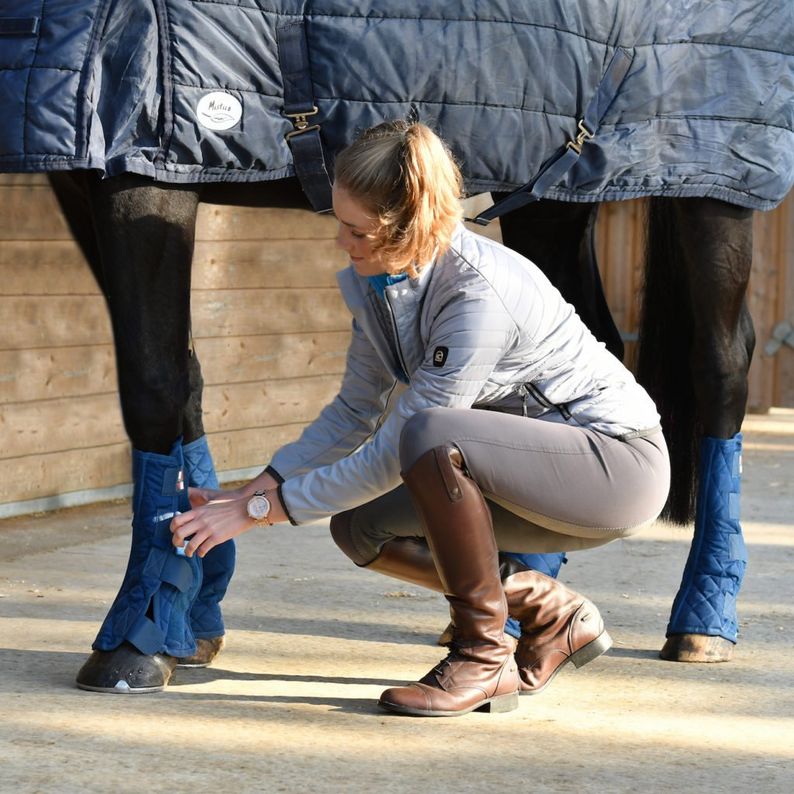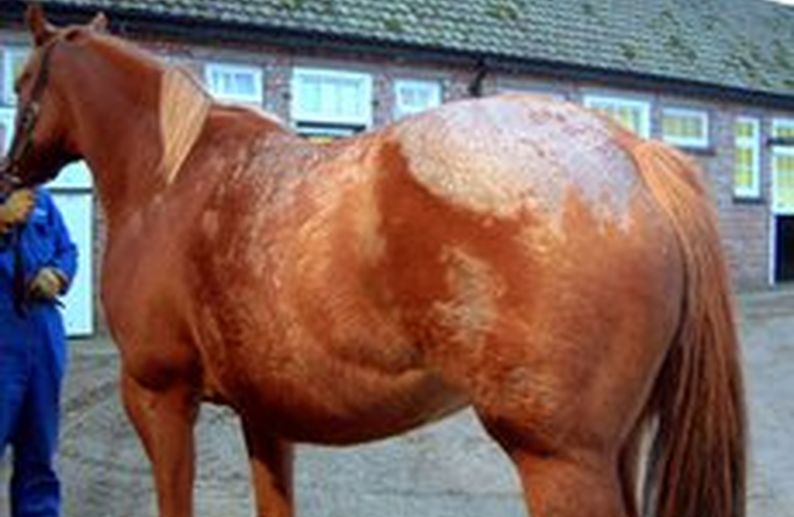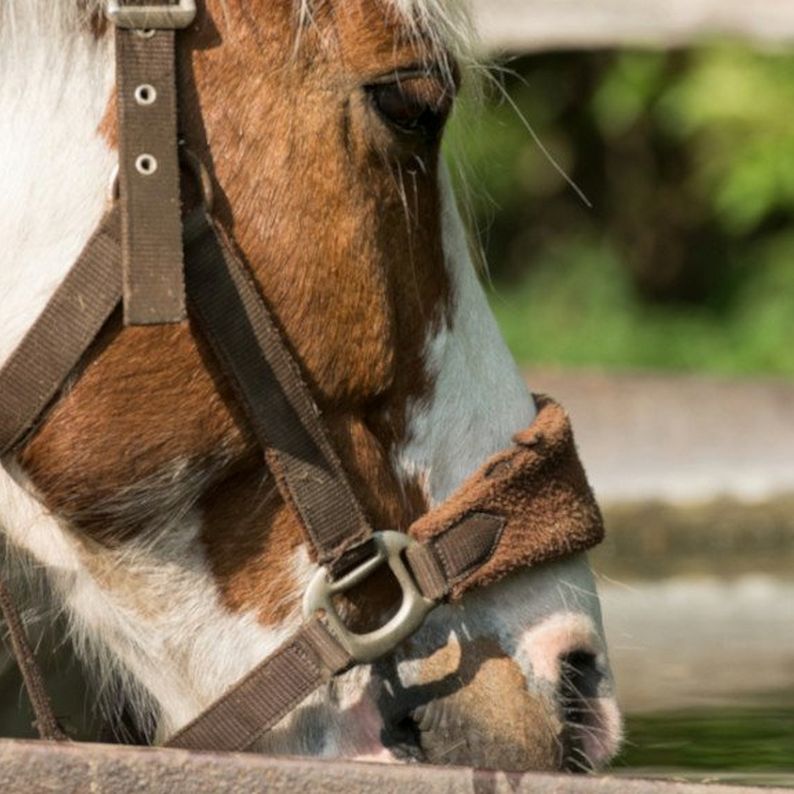
We hate to be the bearers of bad news, but the British summer time is long gone. Sadly, from the 1st October to 1st May, us equestrians are in for a tough time! While our worries about flies and sunburn are fading into the distance, we're not out of the woods yet. Unfortunately, cold, wet weather brings troubles of its own. There are many ailments that are particularly prominent at this time of year. But as we all know, the key to riding out any storm is preparation. So, here we're going to be looking at the common winter horse health problems, how to identify them, treat them and prevent them.
Common Autumn/Winter Ailments
Horse Health – Mud Fever

Perhaps the most common winter horse health concern is mud fever. After-all, with the rain comes mud, with the mud comes mud fever! Officially titled Pastern Dermatitis, mud fever is an uncomfortable and irritating condition, primarily affecting the lower legs. When our horses are exposed to wet pastures for lengthy periods, their skin softens becoming prone to lesions. When their skin is damaged, it allows the bacteria Dermatophilus Congolensis to enter their body. This causes an infection, which results in scabs, lesions and swelling.
As the name suggests, mud fever is most prevalent in wet and muddy conditions. That being said, it can also be triggered by over washing, sweating, incorrectly fitting boots or bandages and dirty bedding. While mud fever often starts small, it doesn't go away on it's own. If left untreated, it can worsen rapidly, eventually causing lameness.
Mud Fever Prevention
Prevention is always better than cure. Rather than waiting for mud fever to strike take action now...
- Avoid your horse standing in muddy conditions for long periods of time by fencing off muddy and boggy areas, adding hardcore to gateways or allowing your horse time in their stable.
- Always check your horse's legs daily for cuts and damaged skin.
- Carefully brush off mud with a soft brush once it’s dried.
- Invest in turnout boots.
- Consider clipping feathered legs, these retain lots of moisture.
- If washing, use an antibacterial soap and ensure the legs are thoroughly dried afterwards.
- Use a mud block cream applied directly to your horse's legs before turnout.
- Ensure your horse has a healthy immune system by adding supplements to their diet where needed.
Mud Fever Treatment
- Legs must be kept clean and dry for them to heal. So, it may be necessary to stable your horse during treatment.
- Remove the scabs to treat the infection. This must be done carefully as it can be painful for your horse. It's best to soak the scabs with warm water and an antibacterial wash like Gold Label Tri Scrub, NAF NaturalintX EquiCleanse or Lincoln Muddy Buddy Scrub to soften them first.
- Wet legs offer the perfect environment for the bacteria to breed, so always dry them afterwards. To do this, pat the skin down with a towel or use stable boots.
- Clip away leg hair so you can treat the skin directly, this also speeds up drying and makes it easier to monitor the healing process.
- Apply a topical cream to aid healing, such as NAF Wound Cream or NAF MSM Ointment.
- Where possible, expose the legs to air to allow natural healing. Deep cracks and wounds may need dressing.
- Continue treating your horse at least once a day until the mud fever has completely vanished.
- If the mud fever does not begin to improve within a week, you should contact your vet.

Top Tip: Horses that have suffered with mud fever tend to be more prone to it in the future. So, make sure you keep a close eye on their legs and take preventative steps to make sure it does not return.
Horse Health – Rain Scald

Our next horse health concern is perhaps even more nasty, rain scald! Even if your horse has never had rain scald, there's a good chance you've heard of it before. But what you might not know is that it's caused by the same bacteria as mud fever, Dermatophilus Congolensis. Unlike mud fever, rain scald affects the neck, back, flanks and hind quarters.
Symptoms of this condition include matted hair, hair loss and scabs. When the scabs are removed, the skin underneath will appear pink and sore, often with a yellow/green pus. Rain scald is rife during the winter months. It's particularly common amongst horses that are unrugged and thin-skinned young-stock. Aggressive and quick to take hold, catching it early is key. Sadly, it won't go away alone, untreated it will spread along the whole of your horse's body.
Rain Scald Prevention
If you're worried your horse may be prone to rain scald, here's a few preventative measures you can take to keep them safe and well...
- Invest in a good waterproof turnout rug to help keep your horse dry.
- Add field shelters or plant safe trees to provide shelter from the rain.
- Avoid excess brushing and washing to help maintain the natural oils in their coat.
- Avoid brushing, rugging or tacking up your horse when they're wet.
- Stable your horse during extremely wet periods, even if it is only for a few hours to dry out.
- Ensure your horse is healthy and getting all the nutrients he needs to maintain a healthy immune system.
Rain Scald Treatment
Rain scald is not only unsightly, it can be painful too. So, it's really important to treat the condition quickly and effectively. Here's what you can do:
- Keep the affected area clean and dry.
- Remove any scabs by soaking the area with warm water and an antibacterial wash like Gold Label Tri Scrub or NAF NaturalintX EquiCleanse.
- Dry the skin well with a towel or wicking cooler rug.
- Apply a topical cream such as NAF Wound Cream or NAF MSM Ointment to the affected area.
- Continue treating your horse at least once a day until the rain scald has completely vanished.
- If the rain scald does not begin to heal within about a week contact your vet.
Horse Health – Thrush

It's not just people that can get thrush, this is a common concern in horse health too. Thrush is a smelly bacterial infection developing in the sulci, the grooves either side of the frog. The bacteria responsible for thrush thrives in damp, dirty conditions with minimal oxygen. So, during the winter months hooves become the perfect environment. As thrush takes hold, a black discharge develops, and the frog begins to become spongy, detaching from the structures below. Left untreated, this condition becomes both painful and irritating.
Thrush Prevention

Most of us will have treated a horse for thrush at sometime or another. Easy to contract, preventative measures are really important! Here's how you can keep your horse's hooves in tip top condition this season:
- Pick them out twice a day to remove any dirt and debris.
- Ensure regular farrier visits to prevent the frog becoming over grown.
- Keep your horse’s bedding as clean and dry as possible.
- Provide a hardstanding area in their field to allow their hooves chance to dry out.
- Regularly oil or tar their hooves to create a barrier against moisture. We’d recommend a an antibacterial or wet weather product, such as Cornucrescine Teatree Hoof Oil, Cornucrescine Hoof Barrier or Lincol Pine Tar Hoof Spray.
- Ensure you’re horse’s diet contains all the essential vitamins and minerals for healthy hooves by providing a supplement such as Carr and Day and Martin® Cornucrescine Daily, Equimins® Hoof Mender Powder, Global Herbs HOOF, or NAF Five Star PROFEET Powder.
Thrush Treatment
While thrush can smell awful, this is often the first sign that it's time to act! If your horse's feet begin to display symptoms, here's how you can treat it quickly:
- Move your horse to a clean, dry environment while treatment is in progress.
- Clean the hooves daily with an antibacterial wash such as Gold Label Tri Scrub or NAF NaturalintX EquiCleanse.
- Dry the hooves with a towel.
- Apply a thrush treatment, such as Leovet Frogmedic Spray, Absorbine® Hooflex Frog & Sole or strong neat iodine.
Horse Health – Colic

The last common horse health concern we'll be looking at... Colic. Enough to make our blood run cold, it's something we all dread. Colic is the general term used to describe digestive upset and abdominal pain. During the winter, colic cases often begin to rise. This is generally as a result of decreased water intake, dietary changes and reduced mobility. Colic symptoms can vary hugely from one horse to the next, but most will attempt to lie down, look at their flanks, paw at the ground, refuse food, become lethargic and sweat up. Colic should always be treated as an emergency, if symptoms are spotted, contact your vet immediately.
Colic Prevention
- Ensure that your horse is drinking plenty of water. If they can be reluctant, take a look at our top tips here: Water Woes – Encouraging Your Horse To Drink.
- Make changes to their routine gradually. For more tips on how to transition between summer and autumn take a look at our blog: Changing Feed & Management – Autunm/Winter.
- Ensure that your horse is up to date with worming, using the correct product for the season. For more information about worming, take a look at the blog: Horse Worming – How To Guide.
- Encourage plenty or exercise, whether by riding, hand walking or turning out.
There you have it! We hope you've found our winter horse health blog helpful. Fingers crossed, with all these handy preventative tips you'll never need to worry about treatment! You can shop all of the products in this blog and many more at www.naylors.com or in-store. Don’t forget, if you make a purchase share your pictures with us in the comments or include #NaylorsSnapAndShare on your social posts for the chance to win a Naylors gift card!





